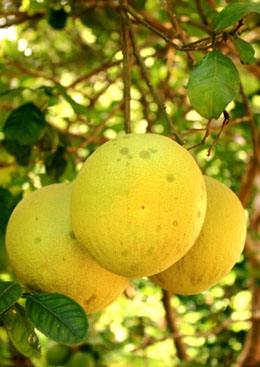A pomelo tree needs the optimal growth conditions to thrive properly. Being a subtropical tree, it grows well in warm climates. Find out how to grow and care for a pomelo tree by going through this article.

The pomelo is a citrus fruit, which is usually considered an ancestor of the grapefruit. But it is much larger than the grapefruit in size. In fact, the pomelo is known as the largest member of the citrus fruits. A pomelo can be up to 15 to 25 cm in diameter, and weigh about 2 to 4 pounds.
The fruit can be identified by its rough skin that turns pale green or yellow, when the fruit ripens. A pomelo tastes like a grapefruit, but without the grapefruit's bitterness. The membrane that is found around the segments of the fruit is bitter, and is not considered edible. Pomelo is also known as Chinese grapefruit, pummelo, shaddock, jabong, and pommelo.
Pomelo Tree Information
It is a large tree that can reach a height of about 5 to 15 m. The tree looks bushy with an irregular crown. The bark of the tree is yellow in color. The leaves are dark green in color with numerous oil glands that look like small dots. These oil glands give the leaves a shiny appearance.
The leaves of the pomelo tree are simple. Like the leaves, the skin of the fruit is also dotted with oil glands. The tree produces white or yellowish white, fragrant flowers. The fruit is usually round or oblong in shape, and it consists of several segments that remain surrounded by a papery skin or membrane. The flesh is juicy and can be white to light yellow, or pink in color. Being a subtropical plant, it prefers a warm climate and high level of humidity.
Pomelo Tree Maintenance
To grow a healthy pomelo tree, first of all, you have to know the optimal growth conditions required by this tree. The pomelo is a subtropical evergreen tree, and so, it thrives in warm climates. A warm sunny location is ideal for growing this tree. However, compared to other trees of the genus
Citrus, it can withstand shade to an extent.
But for harvesting high quality fruits, it is better to choose a sunny location for growing this tree. Otherwise, the fruits would be sour. The availability of adequate sunlight ensures that the tree remains healthy. However, excessive exposure to strong direct sunlight is also not advisable. So, choose a place that can provide adequate sunlight, and at the same time, offer a little bit of shade to the tree.
The tree can adapt itself to various types of soil. However, the soil should be well-drained. During the growing season and until the plant establishes itself firmly on the ground, it requires regular watering. The pomelo tree and other members of the citrus family do not require heavy pruning at regular intervals. If the tree looks too dense, you can thin the inner foliage a bit, in order to promote air circulation. Be sure to remove the suckers growing from the root stock.
Occasionally, the pomelo tree can become susceptible to some plant diseases that commonly affect the trees of the citrus family. The most common pests that can attack this tree are, miller insects, anthracnose fungi, and louses. If the pest invasion becomes a serious problem, then consider to take the help of a professional.






 The pomelo is a citrus fruit, which is usually considered an ancestor of the grapefruit. But it is much larger than the grapefruit in size. In fact, the pomelo is known as the largest member of the citrus fruits. A pomelo can be up to 15 to 25 cm in diameter, and weigh about 2 to 4 pounds.
The pomelo is a citrus fruit, which is usually considered an ancestor of the grapefruit. But it is much larger than the grapefruit in size. In fact, the pomelo is known as the largest member of the citrus fruits. A pomelo can be up to 15 to 25 cm in diameter, and weigh about 2 to 4 pounds.